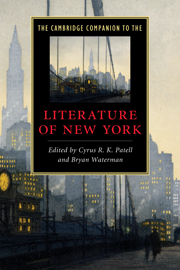Book contents
- Frontmatter
- Introduction
- 1 From British outpost to American metropolis
- 2 Dutch New York from Irving to Wharton
- 3 The city on stage
- 4 Melville, at sea in the city
- 5 Whitman’s urbanism
- 6 The early literature of New York’s moneyed class
- 7 Writing Brooklyn
- 8 New York and the novel of manners
- 9 Immigrants, politics, and the popular cultures of tolerance
- 10 Performing Greenwich Village bohemianism
- 11 African American literary movements
- 12 New York’s cultures of print
- 13 From poetry to punk in the East Village
- 14 Staging lesbian and gay New York
- 15 Emergent ethnic literatures
- Further reading
- Index
- Series list
15 - Emergent ethnic literatures
Published online by Cambridge University Press: 28 November 2010
- Frontmatter
- Introduction
- 1 From British outpost to American metropolis
- 2 Dutch New York from Irving to Wharton
- 3 The city on stage
- 4 Melville, at sea in the city
- 5 Whitman’s urbanism
- 6 The early literature of New York’s moneyed class
- 7 Writing Brooklyn
- 8 New York and the novel of manners
- 9 Immigrants, politics, and the popular cultures of tolerance
- 10 Performing Greenwich Village bohemianism
- 11 African American literary movements
- 12 New York’s cultures of print
- 13 From poetry to punk in the East Village
- 14 Staging lesbian and gay New York
- 15 Emergent ethnic literatures
- Further reading
- Index
- Series list
Summary
In the final chapter of Chang-rae Lee's first novel, Native Speaker (1995), the protagonist, a Korean American named Henry Park, thinks about the streets of Flushing, Queens, and why he loves them:
I love these streets lined with big American sedans and livery cars and vans. I love the early morning storefronts opening up one by one, shopkeepers talking as they crank their awnings down. I love how the Spanish disco thumps out from windows, and how the people propped halfway out still jiggle and dance in the sill and frame. I follow the strolling Saturday families of brightly wrapped Hindus and then the black-clad Hasidim, and step into all the old churches that were once German and then Korean and are now Vietnamese. And I love the brief Queens sunlight at the end of the day, the warm lamp always reaching through the westward tops of that magnificent city.
The novel's epigraph comes from Whitman's poem “The Sleepers”: “I turn but do not extricate myself, / Confused, a past-reading, another, but with darkness yet.” The lines are drawn from a passage in which the poem's narrator has just imagined “a beautiful gigantic swimmer swimming naked through the eddies of the sea,” a swimmer who is ultimately dashed to death against the rocks: “Swiftly and out of sight is borne the brave corpse.” Lee's novel, like Whitman's poem, is haunted by loss, occurring in the aftermath of the death of the narrator's son, Mitt, who is inadvertently suffocated at the bottom of a “dog pile” of neighborhood boys. Despite the bitter memories that they evoke, the streets of Flushing remain a source of hope and promise for Henry Park.
- Type
- Chapter
- Information
- The Cambridge Companion to the Literature of New York , pp. 218 - 231Publisher: Cambridge University PressPrint publication year: 2010

